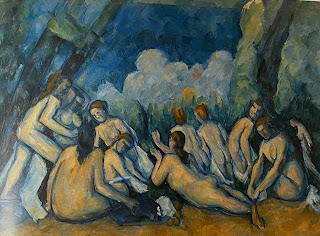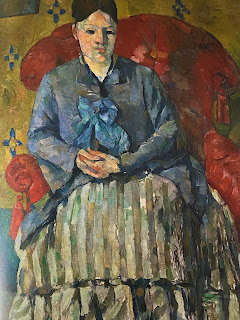Cezanne at Tate
Cezanne has rolled into town, just as emphatically as his gravity-defying fruits do NOT roll off their tables in his many still life paintings. “With an apple I will astonish Paris”, is the quote taken as the motto for his arrival – in London.
A great collection of Cezanne’s work is exhibited at Tate Modern for over 5 months between October 2022 and March 2023. Go early and go often, to adapt the C19 election voting advice. There is much to be dazzled, or even perplexed, by.
A one-sentence summary of Cezanne’s place in modern art history might say that he took the loose and transient realism of Impressionism to the edge of Cubism and thus initiated the worlds of Abstract Art. He worked with an obsessional attention to colour and form; indeed, to form created by colour, and a gradual abandonment of realist perspective.
Cezanne painted his subjects over and over again, each time trying to express what he saw differently in the same view, and never being satisfied that he captured the essence of the scene or objects before him, or hit on the proper relation of artist to subject.
In the Exhibition, this can be clearly appreciated. Three pictorial themes may stand as examples: Cezanne’s Fruits, his Bathers, and Mont St Victoire. In all these series “realism” gives place over time and compositions to strange geometries and the glories of colour – and in some cases the draining of shapes and contrasts.
Thus, the colours of fruits no longer go to defining the “appleness” or “lemonness” of particular objects but rather blaze an intoxicating coloured pattern out of the frame and across the gallery space.
A landscape of trees, fields, valleys and mountain subtly lends or borrows shapes and colours and, as the series progresses, shape and hue become more detached from the geography of the scene.
What starts as heavy, almost awkward nude studies of bathers gradually assimilate to the forms and colours of surrounding foliage and water.
Play this game with any children you take, or with your friends, or indeed with yourself. Spot the oddities or deviations from “naturalism” in the paintings – for example: those apples should topple; that statue should slide or tip;
where does the sitter end and the sofa begin;
is that mark foliage on a near tree, or suggesting a meadow on a far mountain; can a white house set back from water nevertheless be reflected there?
Reflect in turn how the compositions are liberated from, but rooted in, the scenes depicted, which are starting points for adventures in vivid perception.
Nov 2022










